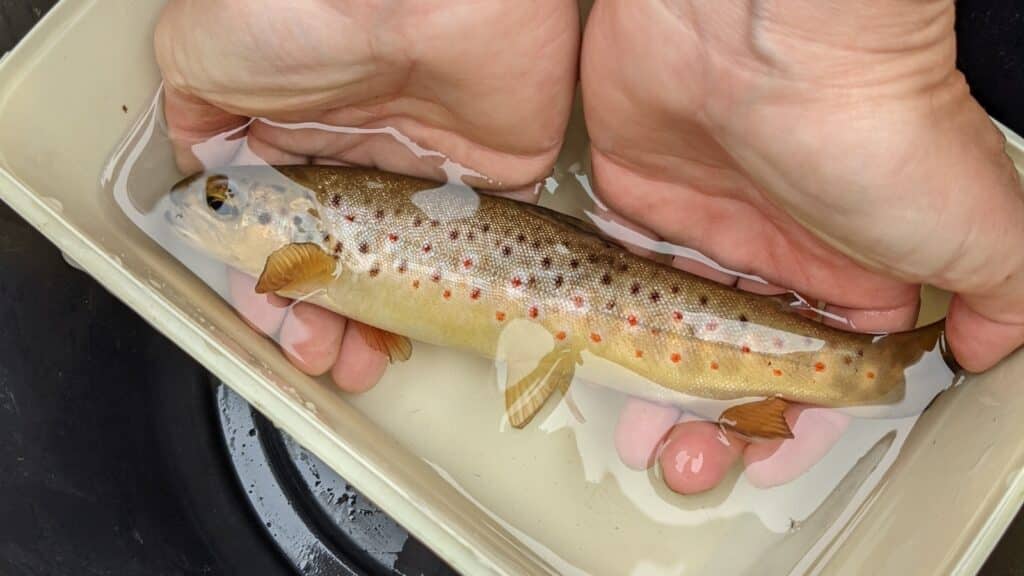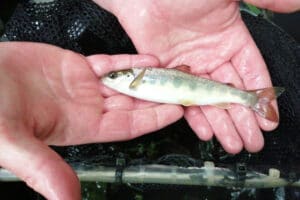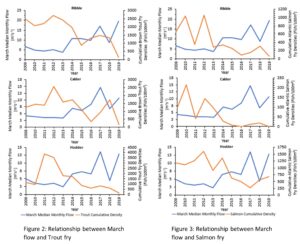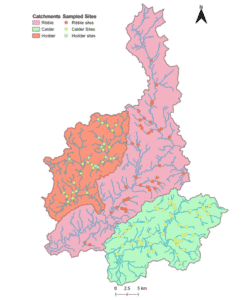For the a number of years the UK, and more specifically the Ribble catchment, has experienced low rainfall in the summers, followed by severe flooding in winter. During these years there has also been a drop in the numbers of juvenile fish in the Ribble’s river catchment.

Today’s blog comes courtesy of Rob Starkie, who is a student at University of Liverpool. It looks at the research undertaken as part of Rob’s MSc research project.
The Relationship between high flow events and fry populations on the Ribble Catchment. Rob Starkie – M.Sc. student at University of Liverpool

For my MSc research project, I looked into the potential reasons for the number of Salmon and Trout declining in the Ribble system as reported by The Ribble Rivers Trust in their 2020 fisheries report. It was thought that high flows during early life stages of Salmon and Trout were a possible cause for this decline. As future climate change scenarios show that the UK is set to experience wetter winters, it is likely that Salmon and Trout populations are going to feel the effects of this, through higher flows.
So, I decided to look into the into the flow regime of the Ribble and see if there is a relationship between high flows and the number of Salmon and Trout fry. The flow regime of a river can be thought of as the personality of the river, which is made up by different behaviours. These behaviours can be described as the size, frequency, duration, and timing of the river flow and these behaviours give the river their personality or river flow regime.
By using daily flow records from the National River Flow Archive (NRFA) and a statistical computer programme I could examine the flow regime of the 3 different rivers. I found that the long term annual flow of the Ribble, Calder and Hodder all experience ‘wet’ and ‘dry’ years, when compared to their long term average. I also found that they have all experienced a high number of ‘wet’ years since 2009. By looking at long term flow records for the Ribble, Calder and Hodder my research also found that they all show similar personalities and behaviours. They all experience the highest flows in December and January and the lowest flows in July, as you might expect.
By comparing their long term behaviour with their behaviour over the 10-year period since 2009, I found a clear change in their personality. All 3 rivers showed much higher flows in December, February, and the summer months, but how does this impact Salmon and Trout?

By using data from The Ribble Rivers Trusts summer fry surveys I could look at the relationship between river flow and Salmon and Trout fry (Figure 2 and Figure 3). A significant relationship was found between river flow in March and the number of Salmon and Trout fry. Higher flows in March coincided with years that recorded lower numbers of fry, and lower flows in March coincided with years that recorded higher numbers of fry. This relationship can be explained by the fact this period is when Salmon and Trout begin their emergence phase. During this phase Alevins are more at risk of being washed downstream out of their gravel Redds, due to their small size and limited swimming ability.
The low numbers of Salmon and Trout seen in 2019 and 2020 can be linked to the number of storms occurring in February and March. In March 2019, storms Freya and Gareth occurred in quick succession resulting in much higher rainfall than expected. This resulted in higher flows, and likely had an adverse effect on Salmon and Trout fry and contributed to the lower numbers recorded that year.

My research also looked into the relationship between temperature and the number of Salmon and Trout fry and fish in the Ribble. A relationship was found between average winter temperature and the number of Salmon and Trout fry, with lower numbers occurring in colder years and higher numbers occurring in warmer years. This relationship is explained by colder winters being linked lower survival rates of eggs, due to an increased chance of the eggs freezing. Also, the length of the incubation period of eggs is related to temperature, with colder temperatures resulting in longer incubation periods. So, colder winters will lead to Alevins emerging later, and therefore they will have less time to grow and are more vulnerable to wash out.
These findings show that early life stages of Salmon and Trout are vulnerable to high flow events and lower temperatures, and that they are contributing factors to why Salmon and Trout populations are experiencing a decline in the Ribble. Although we cannot change the weather, knowledge of these relationships can be used to help make decisions about the future management of the Ribble catchment.
To read Rob’s full dissertation click here, or to read Ribble Rivers Trust’s annual monitoring reports and discover what fish are in the Ribble, click here.
fish in the ribble

